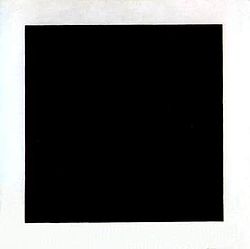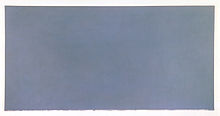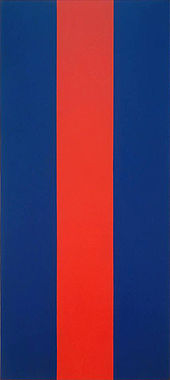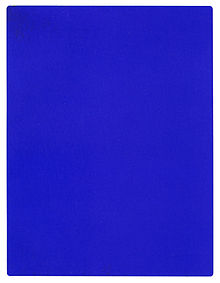- Monochrome painting
-
Monochromatic painting has been an important component of avant-garde visual art throughout the 20th century and into the 21st century. Painters have created the exploration of one color, the examination of values changing across a surface, the expressivity of texture and nuance, expressing a wide variety of emotions, intentions and meanings in a wide variety of ways and means.[1] From geometric precision to expressionism, the monochrome has proved to be a durable idiom in Contemporary art.[2]
Contents
Origins
A canvas is never empty.A late 1990s article in Art in America asserts that “monochrome painting” began as a joke.[citation needed] The article states that it was merely a whimsical pastime of salon life in late 19th century France. A typical example, which may be familiar from popular puzzle books, might be a blank page or canvas bearing the title “A White Cow in a Snowstorm.” However, this kind of activity bears more similarity to 20th century Dada, or Neo-Dada, and particularly the works of the Fluxus group of the 1960s, than to 20th century monochrome painting since Malevich.
The wide range of possibilities (including impossibility) of interpretation of monochrome paintings is arguably why the monochrome is so engaging to so many artists, critics, and writers. Although the monochrome has never become dominant and few artists have committed themselves exclusively to it, it has never gone away. It reappears as though a spectre haunting high modernism, or as a symbol of it, appearing during times of aesthetic and sociopolitical upheavals.[4]
Suprematism and Constructivism
 Kazimir Malevich, Black Square on a White Field, 1913, Oil on Canvas, State Russian Museum, St. Petersburg
Kazimir Malevich, Black Square on a White Field, 1913, Oil on Canvas, State Russian Museum, St. Petersburg
Monochrome painting as it is usually understood today began in Moscow, with Suprematist Composition: White on White [5] of 1918 by Suprematist artist Kazimir Malevich. This was a variation on or sequel to his 1913 work “Black Square on a White Field”, a very important work in its own right to 20th century geometric abstraction.
In 1921, Constructivist artist Alexandr Rodchenko exhibited three paintings together, each a monochrome of one of the three primary colours. He intended this work to represent The Death of Painting.[6]
While Rodchenko intended his monochrome to be a dismantling of the typical assumptions of painting, Malevich saw his work as a concentration on them, a kind of meditation on art’s essence (“pure feeling”).
These two approaches articulated very early on in its history this kind of work’s almost paradoxical dynamic: that one can read a monochrome either as a flat surface (material entity or “painting as object”) which represents nothing but itself, and therefore representing an ending in the evolution of illusionism in painting (i.e. Rodchenko); or as a depiction of multidimensional (infinite) space, a fulfillment of illusionistic painting, representing a new evolution—a new beginning—in Western painting’s history (Malevich). Additionally, many have pointed out that it may be difficult to deduce the artist’s intentions from the painting itself, without referring to the artist’s comment.
Artists
New York
Abstract Expressionists
Main article: Abstract Expressionism(January 7, 1917 Bratslav, Rodolia, Ukraine - March 12, 2004 New York, New York, USA) had a long career as an Abstract Expressionist painter. Initially, during the 1940s, he explored the then-current style of Action Painting. His later work, from the 1950s through the 1970s is often characterized as Abstract Impressionist - largely because he constructed his allover compositions with multiple, repetitive, and close-valued brushstrokes, in the manner of Claude Monet in the famous Waterlilies series. During the final two and a half decades of his painting career Resnick's paintings became monochromatic, albeit with thickly brushed and layered surfaces.
(1913 Buffalo, New York, USA - 1967 New York, New York, USA) was an Abstract Expressionist artist notable for painting nearly “pure” monochromes over a considerable span of time (roughly from 1952 to his death in 1967), in red or blue, and lastly and most (in)famously, in black. Like the Johns works mentioned below, Reinhardt’s black paintings contained faint indications of geometrical shape, but the actual dilineations are not readily visible until the viewer spends time with the work. This tends to encourage a state of contemplative meditation in the viewer, and to create uncertainty about perception; in terms of Frank Stella's famous quote, you may question whether "what you see" is actually what you are seeing.[7]
Although Pousette-Dart (1916 Saint-Paul, Minnesota, USA - 1992 Suffern, New York, USA) created several distinct series of paintings during his long career as an Abstract Expressionist painter, his monochromatic series called Presences spanning the late 1950s through the early 1990s, was among his most powerful.
Color field
Main article: Color FieldBeginning in the 1950s and 1960s, several Abstract Expressionist / color field artists (notably: Barnett Newman, Mark Rothko, Robert Motherwell, Adolph Gottlieb, Theodoros Stamos, Sam Francis, Ludwig Sander, Clyfford Still, Jules Olitski, and others) explored motifs that seemed to imply monochrome, employing broad, flat fields of colour in large scale pictures which proved highly influential to newer styles, such as Post-Painterly Abstraction, Lyrical Abstraction, and Minimalism.
One of Barnett Newman’s near monochrome paintings generated outrage and widespread ridicule (and discussion) in Canada when the National Gallery purchased "Voice of Fire" for a large sum of money, in the 1980s. Another of Barnett Newman’s very sparse (though technically not monochrome) geometric abstractions was slashed with a knife by an enraged viewer in the 1980s at the Stedelijk Museum in Amsterdam.
Lyrical Abstraction
Main article: Lyrical AbstractionLyrical Abstractionist painters such as Ronald Davis, Larry Poons, Walter Darby Bannard, Dan Christensen, Larry Zox, Ronnie Landfield, Ralph Humphrey, David Budd, David R. Prentice, David Diao, David Novros, Jake Berthot, and others also explored and worked on series of shaped and rectangular canvases that approached the monochrome - with variations especially during the 1960s and 1970s.
Shaped canvas
Main article: Shaped canvasSince the 1960s artists as diverse as Frank Stella, Ellsworth Kelly, Ronald Davis, David Novros, Paul Mogensen, Patricia Johanson and others made monochrome paintings on various shaped canvases. While some of their monochromatic works related to minimalism none of the above were minimalists.
Neo-Dada
In the early 1950s, Rauschenberg (b. 1925, Port Arthur, Texas, USA; d. 2008) became known for white, then black, and eventually red monochrome canvases. In the White Paintings (1951) series, Rauschenberg applied everyday house paint with paint rollers to achieve smooth "blank" surfaces. White panels were exhibited alone or in modular groupings. The Black Paintings (1951–53) incorporated texture under the painted surface by way of collaged newspaper that sometimes indicates a grid-like structure. The Red Paintings (1953–54) incorporate still more materials such as wood and fabric under the heavily worked painted surface, and seem to foreshadow Rauschenberg's development of assemblage in his "Combine Paintings" as well as his stated intention to act in "the gap" between "Art" and "Life."
- The white canvases became associated with the work 4'33" by the composer John Cage, which consisted of three movements of silence, and was inspired at least in part by Cage's study of Zen Buddhism. In both works attention is drawn to elements of listening / viewing which lie outside the artist's control: eg. the sounds of the concert environment, or the play of shadows and dust particles accumulating on the 'blank' canvas surfaces ("landing strips" -- Cage).
- In a related work, his Erased de Kooning Drawing of 1953, Rauschenberg erased a drawing by abstract expressionist artist Willem de Kooning. Perhaps surprisingly, De Kooning was sympathetic to Rauschenberg's aims and implicitly endorsed this experiment by providing the younger artist with one of his own drawings which was very densely worked, taking 2 months and many erasers for Rauschenberg to (incompletely) erase.
(b. 1930, Augusta, Georgia, USA) was a friend of Rauschenberg, and both were often categorized as Neo-Dadaist, pointing to their rejection of the Abstract Expressionist aesthetic which was dominant in the 1950s. Johns painted a number of works such as "White Flag," "Green Target," and “Tango,” in which there is only a slight indication of an image, resembling the "White Square on a White Field" of Malevich in technique.
- These works often show more evidence of brushwork than is typically associated with monochrome painting. Many other works also approach monochrome, like the melancholic “grey” works of the early ’60s, but with real objects (“assemblage”) or text added.
Minimalists
Main article: Minimalism(b. 1923, Newburgh, New York, USA) spent a lot of time in both Paris and New York. Not strictly a minimalist, he has made a number of monochrome paintings on shaped canvases and single color rectangular panels. His abstractions were “abstracted” from nature. His interest in nature extends so far that he has made a series of plant lithographs in an impressive and sincerely realistic style.
Mino Argento, New York, 1973 #2 (Three squares, pencil lines, gesso and acrylic on canvas. White on White)
(1927, Rome, Italy-) monotones, white on white paintings were variations on the gridded, rectangle on rectangle themes, but were enlivened with differences in rhythm and conception. One composition included grayed grids and vertical rectagles in several, more opaque whites, clustered centrally.[8]
(1912, Macklin, Saskatchewan, Canada - 2004, Taos, New Mexico, USA) whose works of the 1950s and 1960s are serene meditations on “perfection,” and hence “beauty,” are typically white, off-white or pale grey canvases with faint evidence of pencil dragged in lines or grids across the painted surface.[9]
(b. 1930, Nashville, Tennessee, USA) in works such as Ledger (1982) bring the word “constructed” to mind, with attention drawn to supports, framing, and the artist's signature as important elements of works which are usually white, or off-white, and in square format. Abstract Expressionist brushwork is used as formal material in these minimalist constructions. Ryman exhibits a tour de force of variation on a deliberately limited theme.
 Brice Marden, The Dylan Painting, 1966/1986, San Francisco Museum of Modern Art
Brice Marden, The Dylan Painting, 1966/1986, San Francisco Museum of Modern Art
(b. 1938, Bronxville, New York, USA) in his earliest mature works explored a reductive strategy which seemed similar to that of Jasper Johns’s and Ellsworth Kelly's contemporaneous works, yet more formalist: paintings such as Return 1 consist of subtly grey fields painted in encaustic (wax-medium) with a narrow strip along the bottom of the canvas where Marden left bare evidence of process (i.e., drips and spatters of paint). During the late 1980s Brice Marden, who held a spiritual/emotional view of abstraction, began a more multi-colored and calligraphic form of abstract painting.
(b. 1936, Malden, Massachusetts, USA) echoed composer Igor Stravinsky’s famous assertion that “music is powerless to express anything but itself” when he said “What you see is what you see,” a remark he later qualified by saying his early paintings were influenced to a degree by the writing of Samuel Beckett (see above). In his work he was attempting to minimize any inference of “spiritual” or even “emotional” response on the part of the viewer, and this is perhaps most striking in his pinstripe Black Paintings (Marriage of Reason and Squalor - detail - 1959) beginning in the late ’50s, where the pinstripes are articulated by unpainted canvas. Later, Stella abandoned not only monochrome, but also eventually geometric painting.
(b. 1934, Berkeley, California, USA) is characteristically Minimalist in that his "objects" aren't adequately categorized as "painting" or "sculpture." Famous since 1965 for "slabs, columns, planks ... Neutral forms," his meticulously finished, polished monochrome objects are often simply leaned up against gallery walls, in what some critics describe as a casual "West Coast-lean." Although he draws from techniques characteristic of surfboard manufacture, his works are personally and meticulously handcrafted, unlike those of John M. Miller and other more recent artists, which are typically factory-made according to the artist's specifications.
(b. 1944, Los Angeles, California, USA) determined in the mid-1970s that the social forces that give paintings meaning may be better understood if the "painting" itself could be reduced to a generic form—a painting that could read as a "sign" for a painting," which could function of a "placeholder," or a kind of "prop." In the 1970s and early 80s he painted what he called Surrogate Paintings, and ultimately began casting them in plaster, frame and all. These hundreds of objects that looked like framed, matted, fields of painted blackness, worked as neutral, "generic signs" that might inspire the viewer to think about the social expectations that constructed the "idea" of a painting," more than the actual painting itself. By reducing paintings to mere signs of themselves, McCollum turned the gallery and the museum setting into a kind of theater, highlighting the drama of presenting, displaying, buying and selling, exchanging, photographing, assessing, criticising, choosing, and writing about the works; the object-paintings at the center of the action were purposely rendered moot, in order to turn one's attention to the supplementary devices and social practices that, in the end, bestow the value on the work. Paradoxically, as time went by, these neutral objects became valuable in themselves, as symbols of an anthropological way of looking at art.
(1921–2004) was an American artist of the mid-20th century; she is associated with both minimalism and Color Field artists like Morris Louis and Kenneth Noland. Primarily thought of as a minimalist sculptor, and as a colorist who painted her sculpture, throughout her career Truitt produced several series of Monochromatic paintings.
- She made what is considered her most important work in the early 1960s anticipating in many respects the work of minimalists like Donald Judd and Ellsworth Kelly. She was unlike the minimalists is some significant ways. She named, for instance, many of her works after places and events that were important to her - a practice suggesting a narrative beyond and yet somehow contained by the sculpture.
- The sculpture that made her significant to the development of Minimalism were aggressively plain and painted structures, often large. The recessional platform under her sculpture raised them just enough off the ground that they appeared to float on a thin line of shadow. The boundary between sculpture and ground, between gravity and verticality, was made illusory. This formal ambivalence is mirrored by her insistence that color itself, contained a psychological vibration which when purified, as it is on a work of art, isolates the event it refers to as a thing rather than a feeling. The event becomes a work of art, a visual sensation delivered by color.
Europe
From 1949 on Fontana started the so-called Spatial Concept or slash series, consisting in holes or slashes on the surface of monochrome paintings, drawing a sign of what he named "an art for the Space Age" (Concetto spaziale (50-B.1), 1950, MNAM, Paris).
Monochrome works: The Blue Epoch
Although Klein had painted monochromes as early as 1949, and held the first private exhibition of this work in 1950, his first public showing was the publication of the Artist's book Yves: Peintures in November 1954. Parodying a traditional catalogue, the book featured a series of intense monochromes linked to various cities he had lived in during the previous years. Yves: Peintures anticipated his first two shows of oil paintings, at the Club des Solitaires, Paris, October 1955 and Yves: Proposition monochromes at Gallery Colette Allendy, February 1956. These shows, displaying orange, yellow, red, pink and blue monochromes, deeply disappointed Klein, as people went from painting to painting, linking them together as a sort of mosaic.
"From the reactions of the audience, [Klein] realized that...viewers thought his various, uniformly colored canvases amounted to a new kind of bright, abstract interior decoration. Shocked at this misunderstanding, Klein knew a further and decisive step in the direction of monochrome art would have to be taken...From that time onwards he would concentrate on one single, primary color alone: blue." Hannah Weitemeier[10]
The next exhibition, 'Proposte Monochrome, Epoca Blu' (Proposition Monochrome; Blue Epoch) at the Gallery Apollinaire, Milan, (January 1957), featured 11 identical blue canvases, using ultramarine pigment suspended in a synthetic resin 'Rhodopas'. Discovered with the help of Edouard Adam, a Parisian paint dealer, the effect was to retain the brilliance of the pigment which tended to become dull when suspended in linseed oil. Klein later patented this recipe to maintain the "authenticity of the pure idea."[11] This colour, reminiscent of the lapis lazuli used to paint the Madonna's robes in medieval paintings, was to become famous as 'International Klein Blue' (IKB). The paintings were attached to poles placed 20 cm away from the walls to increase their spatial ambiguities.
The show was a critical and commercial success, traveling to Paris, Düsseldorf and London. The Parisian exhibition, at the Iris Clert Gallery, May 1957, became a seminal happening[12]; As well as 1001 blue balloons being released to mark the opening, blue postcards were sent out using IKB stamps that Klein had bribed the postal service to accept as legitimate.[13] An exhibition of tubs of blue pigment and fire paintings was held concurrently at Gallery Collette Allendy.
(b. 1932, Dresden, Germany) is an artist who is probably best known for his technically stunning photo-realist paintings, which overshadow his abstract and monochrome works. Both his abstract and representational works seem to cover similar emotional terrain, a kind of ironic pessimism which made his work very fashionable in the late 1980s. His grey paintings, are made by drawing “expressive” gestures in wet paint.
(b. 1944, Bern, Switzerland) also has spent considerable time in New York and Paris. In Paris in the ’60s he was a member of the BMPT group, along with Daniel Buren, Michel Parmentier, and Niele Toroni. The group brought forth questions about the notions of authorship and originality, implying that they often did each others’ works, and that the art object was more important than its authorship. Later, in New York in the late ’70s, Mosset undertook a long series of monochrome paintings, during the heyday of Neo-expressionism. He became a founding member of the New York Radical Painting group, radical referring both to an implied radical social stance, as well as a returning to the radical “root” of painting. This re-assertion of social relevance for abstraction, and even the monochrome, hadn’t been emphasized to such a degree since Malevich and Rodchenko. 1980s neo-geo artists such as Peter Halley who assert a socially relevant, critical role for geometric abstraction, cite Mosset as an influence. See: Untitled 1999
Others
- Sally Hazelet Drummond
(b.1924, USA) exhibited her monochromatic paintings during the late 1950s in New York City at the Tanager Gallery, one of the first Tenth Street cooperative galleries. As of 2007 she heroically and impressively continues to paint Monochromatic paintings (See: Presence of the Heart).
- Alan ebnother
(b. Alameda, California, 1952, USA) is an American painter who explores the heratige of momochrome painting, confining himself to the single color green [2]
- Florence Miller Pierce
(b. 1918, Washington, D.C., USA) was a member of the TAOS Transcendental Painting Group in the 1930s, currently residing in Albuquerque, New Mexico. Her square monochromes, made with translucent resin poured onto mirrored plexiglass, seem to glow of their own accord.
- Blažej Baláž
(b. 1958, Nevoľné, Slovakia) with his "double monochrom". Colour versus filings of coins, junk, soil or poppy seed. Painting Poppy Seed Field / Makové pole 2001/02. [3]
See also
- Anti-art (Note: it is disputed, whether or not Monochrome painting is indeed "anti-art," or not)
- International Klein Blue[14]
Monochrome Painting in the Spotlight
The 1998 Tony award winning Broadway play 'Art' employed a white monochrome painting as a prop to generate an argument about aesthetics which made up the bulk of the play.
Sources
- The Tate Gallery on Monochrome
- Artnet page on Monochrome Painting
- Monochromes: From Malevich to the Present by Barbara Rose
- In the age of the monochrome - Art in America - Jan, 2005 by Terry Berne - Find Articles
- Geoffrey Dorfman pays tribute to milton resnick
References
- ^ MoMA on Monochrome
- ^ Monochrome, Tate Gallery
- ^ Art Quotations by Robert Rauschenberg - The Painter's Keys Resource of Art Quotations
- ^ The Primary Colors for the Second Time: A Paradigm Repetition of the Neo-Avant-Garde, Benjamin H. D. Buchloh, October, Vol. 37, (Summer, 1986), pp. 41-52 (article consists of 12 pages), Published by: The MIT Press
- ^ MoMA.org | The Collection | Kazimir Malevich. Suprematist Composition: White on White. 1918
- ^ MoMA | exhibitions | Rodchenko | Red Yellow Blue
- ^ MoMA
- ^ Ellen Lubell, "Group show" (Mino Argento, white on White) Art Magazine, p.11 October 1975
- ^ http://members.aol.com/mindwebart4/agnes2.htm.
- ^ Yves Klein, Weitemeier, Taschen 1994, p15
- ^ Quoted in Yves Klein, Weitemeier, Taschen 1994, p19
- ^ Yves Klein Archive
- ^ [1] The Formidable Blue Stamp of Yves Klein, John Held Jr.
- ^ http://artnetweb.com/abstraction/chrome.html.
External links
- On view at MoMA: Kazimir Malevich. Suprematist Composition: White on White. 1918
- Henri Matisse. View of Notre-Dame. 1914. Oil on canvas. The Museum of Modern Arts, New York, NY, USA.
- Henri Matisse. French Window at Collioure. 1914. Oil on canvas. Musée National d'Art Moderne, Centre Georges Pompidou, Paris, France.
- Singular Forms (Sometimes Repeated): Robert Rauschenberg
- Guggenheim Collection - Pop art - Rauschenberg - Untitled (Red Painting)
- Site devoted to work of Gerhard Richter
- Johannes Meinhardt: Painting as Empty Space: Allan McCollum's Subversion of the Last Painting. AURA. Wiener Secession. Vienna, Austria, 1994
- The Charlotte Jackson Gallery
- Charlotte Jackson Gallery’s Florence Pierce Page
- Charlotte Jackson Gallery’s Olivier Mosset Page
- Olivier Mosset in the Spencer Brownstone Gallery
- Conversation between Alan Ebnother and Chris Ashley April 17 - May 4, 2005
- What's New? - New New Painters - Art in America - July, 1999 by Ken Carpenter - Find Articles
- From Monochrome painting to net art: Thomas Dreher/Birgit Rinagl/Franz Thalmair: Monochromacity as a Reflection of Computing Processes in Internet-based Art
Categories:
Wikimedia Foundation. 2010.





